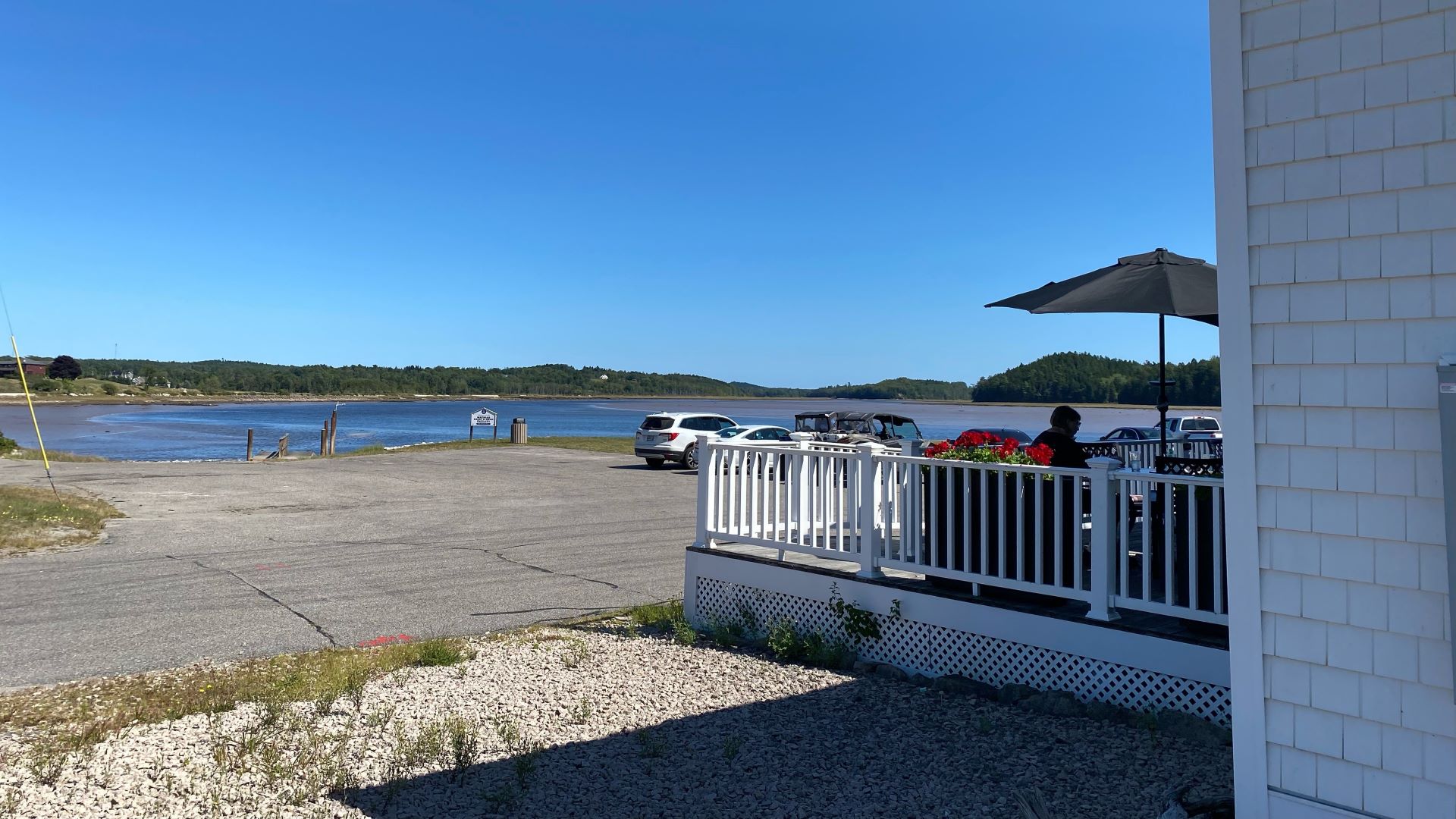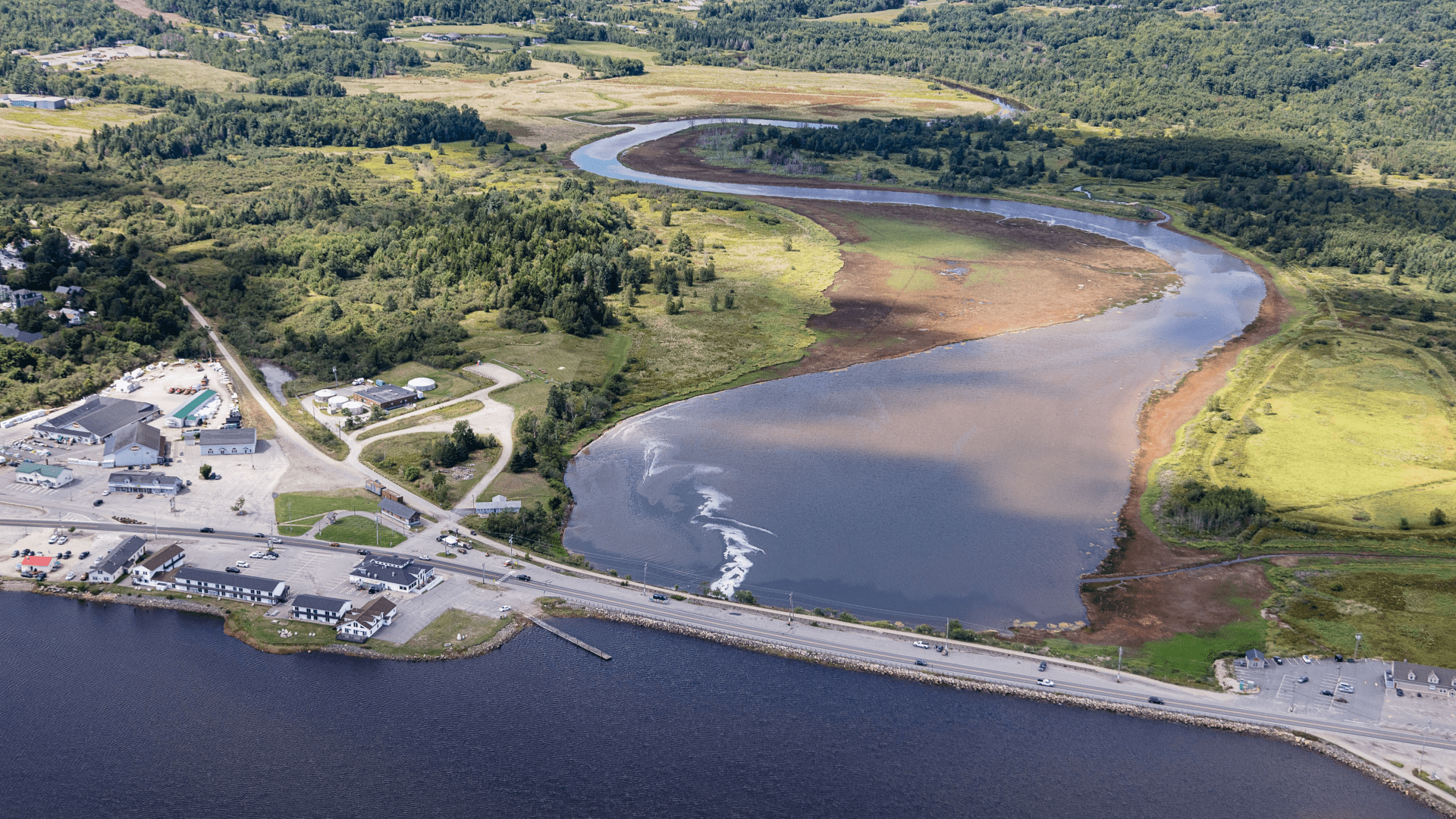One recent late August evening, a few tourists gathered on the deck of Helen’s Restaurant overlooking the Machias River.
The summer holdouts tugged sweaters closer and steadied their glasses while trapping napkins that threatened to fly away. This time of year, the river’s susurrus breezes grow colder and lustier, as if crying out to Machias Bay and the open sea just around the bend.
Come winter, the sea and the bay will answer back with a roar, if last winter’s violent storms are any warning.
“We were like a little island,” said Julie Barker, co-owner of Helen’s Restaurant, a tidy, white-clad building perched at the edge of the river with the Machias dike in its dooryard. “We were surrounded by water until the tide receded.”
Over the past six years, catastrophic storms with surging tides dumped floodwaters in Machias far surpassing the base flood elevation, classifying the events as 100-year floods. Last winter alone, three floods overwhelmed the dike and much of the surrounding downtown, including forcing the town hall to move, a change that has become permanent.
Meanwhile, the eroding, century-old dike — a significant cause of that flooding — remains crippled and inadequately mended. After 15 years of studies, hearings and back-and-forth plans, the public still awaits a Maine Department of Transportation decision about how it will fix the problem — a dike that keeps crumbling and flood waters that keep coming.
The DOT’s decision, or even the status of the environmental impact assessment needed to arrive at a decision, has been delayed yet again — now the public hearing is not expected until fall.
Originally scheduled for the spring, the public hearing was pushed back, then pushed back again this summer. Beyond vague references to additional talks among stakeholders in September, and the public hearing possibly sometime in October, town and state officials remain tight-lipped.
“This is a complex project involving many different issues and stakeholders. I don’t expect to have anything new to add before the public hearing,” said Paul Merrill, the DOT director of communications, in a written response to questions from The Monitor.
Four years ago, the DOT published a “Purpose and Need for Action” report, detailing studies dating to 2016. Since then flood waters have exceeded the base flood elevation eight times, each one chomping at the dike’s foundation.

Last November, after portions of the foundation washed away, the DOT had to temporarily close the dike — a critical span connecting Route 1 on either side of the Machias River at the nexus of Middle River and Machias Bay. Residents were forced to take lengthy detours until a temporary span was erected that month.
A permanent solution is no closer and many experts say the DOT’s preferred, “in-kind” replacement plan won’t prevent or even mitigate flooding.
Merrill told The Monitor, in a June email, that the DOT’s “draft EA (environmental assessment) analyzes alternatives and identifies the fully-gated replacement culverts as the (DOT’s) preferred alternative.”
Merrill added that the Federal Highway Administration would be at a future public meeting to discuss the environmental assessment soon after it is published, for public review and comment. The FHWA will review the comments, then make its final findings. The agency must give the green light for any plan to go forward because the dike spans Route 1, a federal highway.
But the DOT’s draft assessment still hasn’t been made available to the public. Coupled with the public hearing being repeatedly pushed back, Downeast residents and other stakeholders are left in the dark, speculating about the cause and when construction on a replacement dike will begin.
For the last two years, representatives from various private, non-profit groups, and governmental agencies have met as members of the Machias Downtown Resiliency Group to develop a flood mitigation plan. They have worked with the DOT and voiced concerns about the agency’s preferred dike replacement plan.
Town manager Bill Kitchen convenes the group, but when contacted by The Monitor, didn’t offer additional insights about the status of the DOT’s plan beyond confirming the latest timetable for the public hearing, which he said would take place in October.
By then the wind and rising tides will be knocking on winter’s door.
Downtown Machias isn’t the only focus of concerns about the prospect of another violent storm season. The Downeast Salmon Federation and other conservation groups, including Maine Coast Heritage Trust, are in a race to restore salt marshes along the coast, including the Schoppee salt marsh just around the corner from the dike.
The marsh also gets ravaged by violent storms. Tidal surges routinely overtop the adjacent Downeast Sunrise Trail that straddles the marsh and the river, dumping and leaving water in the marsh that doesn’t belong there. The constant deluge compromises the delicate balance of a crucial natural resource.
Last winter was literally the breaking point.
The Downeast Sunrise Trail, which also adjoins the dike on the other side of Route 1, was largely washed away along the river. Tidal waters gouged out entire sections of the trail, leaving the river and bay waters to inundate the marsh’s fragile ecosystem.
The trail was closed, then reopened once repairs were completed by DOT earlier this summer with roughly a half million dollars of funding from the Federal Emergency Management.
Bigger rip rap was put in along the dike and the trail; parking areas were patched; new culverts installed; vast gaps in the trail were filled; and the rebuilt trail topped with a thick bed of crushed stone. A wide, neatly manicured berm was also added, boasting a new picnic bench and two inviting benches, one on each side of the trail overlooking the river and the marsh.
Flood mitigation experts say it all amounts to window dressing.
Foster said culverts won’t hold back the force of the sea, so those pretty new benches won’t be there for long.
Foster said he’s certain if there is another storm event equaling the one on Jan. 10, similar damage will occur because no changes were made to the elevation of the trail – or the dike – and its failed floodgates still block the water from easing into Middle River instead of surging into the town and the marsh.
“The underlying issue still remains … There’s not adequate tidal transparency or flow between the marsh and the river,” said Foster. “And time certainly is of the essence.”
The Downeast Salmon Federation designed a plan that includes installing a bridge over the most vulnerable parts of the trail. Foster said they have several grants pending, totaling roughly $30 million, that would pay for the project. He said the group is confident it will receive the grant awards because the state and federal government have made salt marsh restoration a priority.
But the DOT, which jointly manages the trail with the Maine Division of Parks and Public Lands, also needs to give its blessing.
Marsh restoration projects in other coastal areas have begun, including one being managed by DSF at the west branch of the Pleasant River in Addison. Another marsh restoration at Bells Brook in Columbia, managed by the Maine Department of Marine Resources, was awarded $9 million in July from the National Oceanic and Atmospheric Administration (NOAA) under President Biden’s Bipartisan Infrastructure Law and Inflation Reduction Act.
Foster and others say the best solution for the Schoppee Marsh, as well as for Machias’ residents and businesses, would be to replace the dike with an elevated section and add a series of gated culverts to allow a gradual release of waters into Middle River.
Foster acknowledged it would be expensive, and cost has been a major consideration for the DO, but believes the project could easily be funded with the grant money available through the infrastructure law and from other sources. But he said they need to act fast because that money will dry up soon.
“It’s not going to be a permanent thing,” said Foster. “A lot of that extra money is based on the bipartisan infrastructure law … and you’re only looking at a couple more years of that kind of surge of money.

Costs also are a concern for residents who have to brace for the worst.
Julie and David Barker, who own Helen’s Restaurant, spent about $5,000 this year shoring up the banks below the restaurant with more prodigious rip rap. They also pay an extra $2,000 for flood insurance.
Although they came through last year’s furious storms mostly unscathed, the owners of this 75-year-old Machias landmark know the devastation that the elements wreak. The restaurant burned to the ground in 2014. By then flood waters were already another threat. So the Barkers rebuilt above the floodplain.
“We are not concerned about our building, but I would be concerned about passage,” said Julie Barker. “The Dunkin Donuts side of the causeway looks really bad if you look under the guardrails.”







